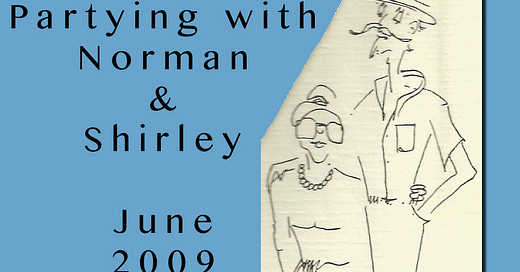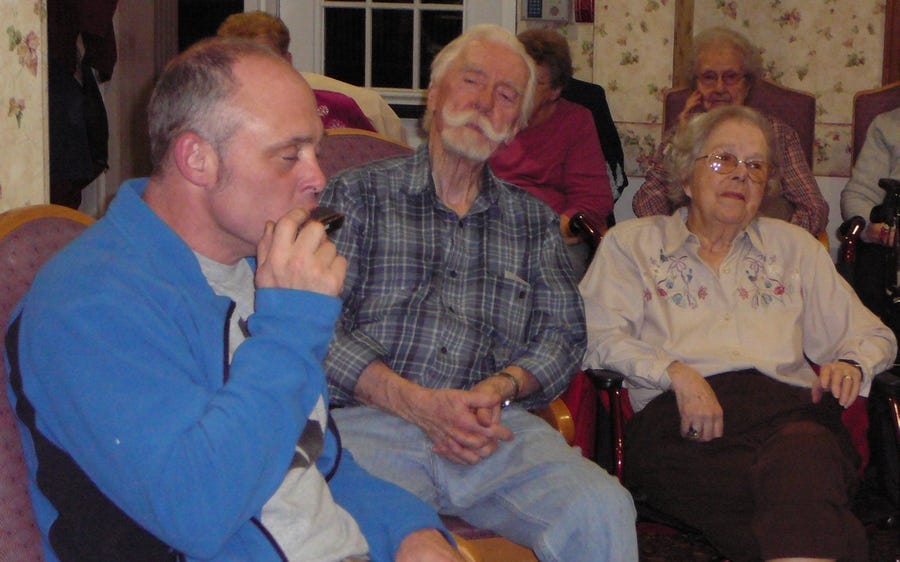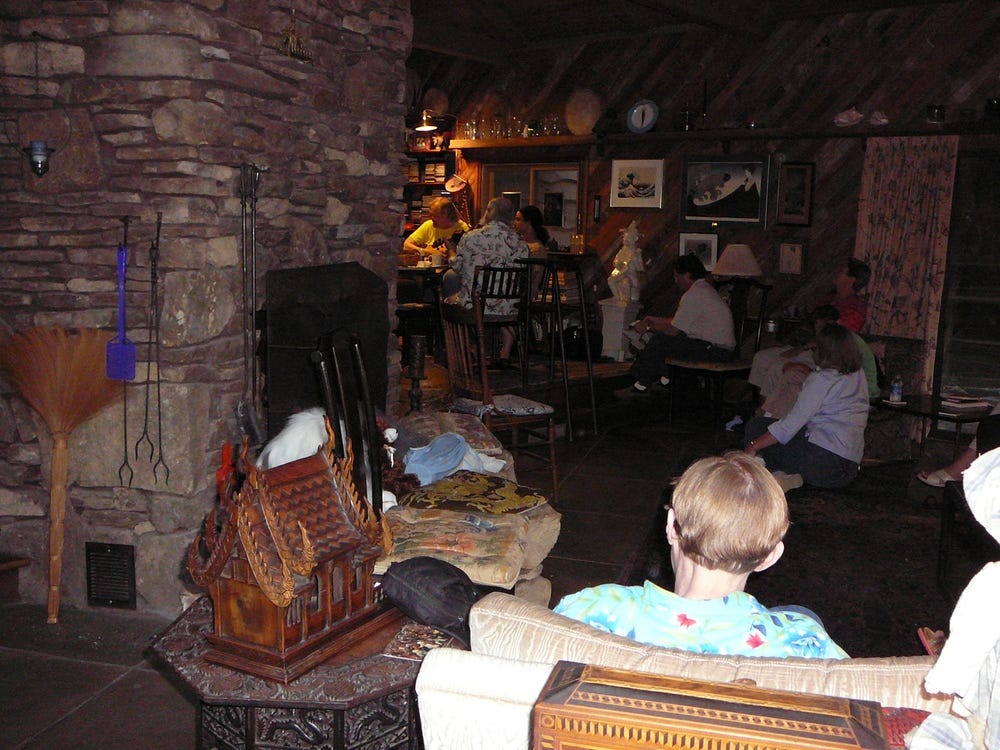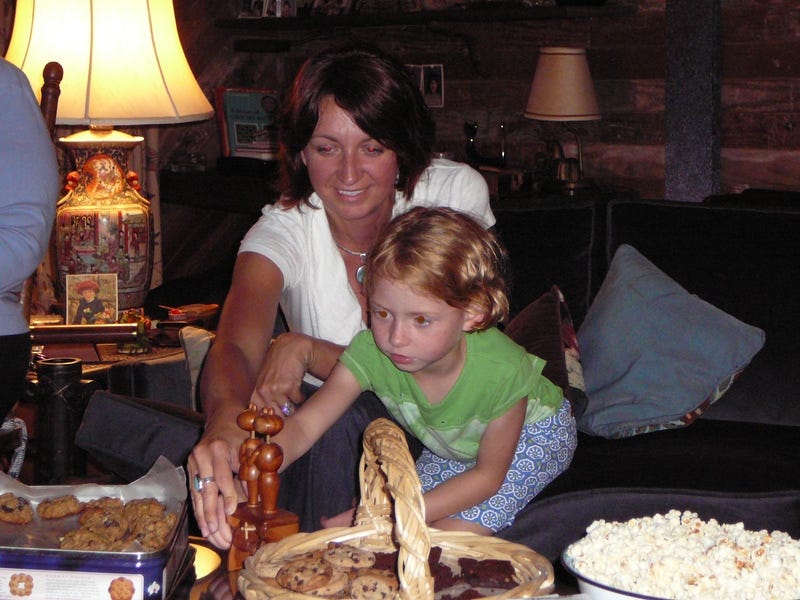Thirteen years ago this week, we took The Flood’s weekly jam session down the road to visit new friends. Now, Norman and Shirley Davis had been in the band's circle for only four months, but already they were confirmed Flood addicts. The pair regularly attended shows and had claimed their favorite corner for the weekly gatherings at the Bowen house.
In fact, as we reported earlier (“The Night TV Came Calling,” Feb. 5), the Davises’ very first jam session actually happened to be documented! If you revisit that page and zip the Tim Irr video forward to about 02:05, you’ll see Shirley and Norman being interviewed and telling how our mutual friend — the beloved Rose Marie Riter — nudged them into the Floodisphere.
Well, by spring 2009 Norman and Shirley were ready to introduce their daytime life to the new nighttime music obsession; they called in friends and neighbors and invited the whole Flood family to hold a jam session in the living room for their gorgeous home on Davis Creek Road.
It was a rainy, chilly evening, but that didn't stop the entire band from showing up, along with spouses and camp followers.
The venue was amazing, as Pamela’s classic photos of the evening show. The original part of the house was Norman's grandfather’s, in the middle of his farm. There were houses nearby, but it’s still “out there,” as Norman put it, with a creek and woods behind the house.
The house itself was designed by Norman, a Renaissance man and sometimes architect. He wanted to prove a house could be built with salvaged materials, and this was way before “recycling” was even thought of by most folks. One wall of their bedroom was an apartment house floor. One wall was stones he collected from the creek. Their living room floor was poured concrete, stained and scored so that it looked like stone. They had a huge ancient stove from a Boy Scout camp, a door that looked like it came from a school and much more. There were no doors -- you could walk from the kitchen to the living room to the bedroom to a study and into the kitchen in a circular pattern.
Huge windows at the back of the house let you see the creek and woods, and there were no curtains on the huge bathroom windows. It was like jamming in a fascinating museum.
Newcomers that night to whom the Davises introduced all things Flood had a ball; conversation between tunes covered quite a spectrum.
For instance, at one point, one of the Flood neophytes commented that we could have an old-fashioned tent revival right there in that living room. This remark inspired Peyton and Bowen to reach back for some rollicking religious tunes they used to do in the earliest days of The Flood in the 1970s. Click the button below for three of those back-to-back songs from the evening at the Davises:
As you'll hear on the audio track, by the end of the third tune, one of the party-goers has found a makeshift "snake" to make appearance, not, as he says, for The Rapture, but for "The Rupture." Fun night.
Postscript: The Flood’s First Family
The Davises continued to be fixtures in the band’s world for the next decade, attending most of our weekly jam sessions and many of our shows, requesting their favorite tunes, celebrating the Floodsters’ ups, commiserating in their downs.
Shirley died in December 2012 at age 96. (A week or so earlier, Charlie and Pamela had visited her at hospice to talk about all the things her favorite Floodsters were up to. Later Shirley's son, Tony Broh, told us that it had the most animated she had been in days.) Next month, we played at the memorial service for Shirley at Huntington's B'Nai Sholom synagogue, celebrating her life with Norman, her three children, some grandchildren, great-grandchildren and many friends.
Since attending Flood practice sessions was the highlight of Shirley’s last years, the Flood was asked to perform in the social hall as people gathered for dinner. The tables were beautifully decorated and each table contained a large photo of Shirley, sometimes with family members. The dessert table contained a beautiful bust of a younger Shirley that she had sculpted herself. Shirley is still very much with us, her picture holding a place of honor is our weekly rehearsal space.
Meanwhile, Norman continued to be a regular at all manner for Floodishness for another seven or eight years, dancing at our parties and shows, flirting with Michelle, even demonstrating the proper technique for kazoo playing. He made a particularly strong impression on our youngest bandmate, Jacob Scarr.
Just 16 when he joined The Flood in 2009, Jacob found a kindred spirit in the 83-year-old Davis. In fact, the following year, Jacob wrote an essay about Norman for a high school composition class, marveling at Norman’s constant thirst for new knowledge. “Without any type of college education and with no formal training,” Jacob wrote, “Norman taught himself carpentry, plumbing, metalworking, framing, and was even a licensed electrician.
“Norman is constantly on the move,” Jacob added. “Always involved in some project or activity, I’ve never found him at a loss for something to do. While he often remembers fondly people and events from the past and always has an interesting story to tell, Norman never seems to dwell on it. He is constantly looking forward, pursuing life with a joy and an enthusiasm. … I watch him delight in things I often take for granted, he appreciates all that he sees and he takes ever opportunity. Anyone who thinks life slows down or becomes dull with age should look at Norman. He has shown me how much there is to love in life and how easy it is to let it slip by.”
Norman as Storyteller
One of our favorite Norman Davis moments came on a spring night just four years ago, when we invited him to share a story on stage at one of our monthly Route 60 Saturday Night shows. Here’s the video from that night:
Rest in Peace, Norman
Ten years after Shirley’s death, Norman passed away at age 94 after a long illness. At his bedside were his new young wife, Carol, and his daughter, Esta Browning, who wrote of her father, “He said all of the things he wanted to say and experienced more than his childhood self could ever have imagined.”















